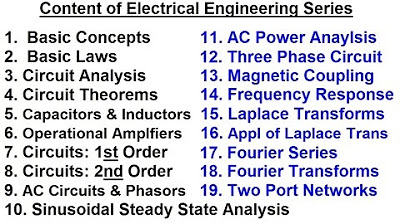Coupling Capacitor (Unit 4 Analysis of BJT circuits & small signal Amplifier) Basic Electronics
Summary
TLDRThe video introduces Unit 4, covering the AC analysis of small signal amplifiers. The instructor explains the role of capacitors in connecting two circuits and how they allow AC signals to pass while blocking DC signals. The concept is illustrated using a practical example involving a microphone (Circuit 1) and a recording device (Circuit 2), where AC signals from the microphone are transmitted while DC power is blocked. The explanation touches on key electrical concepts such as frequency, resistance, and signal behavior, making the content accessible for learners. The video ends with a thank you message.
Takeaways
- 🔧 The video discusses the introduction of Unit 4, focusing on small signal amplifiers and their AC analysis.
- 🔌 Explanation of connecting two circuits, emphasizing the role of capacitors in blocking DC signals and allowing AC signals to pass.
- 🎛️ A capacitor blocks DC signals with infinite resistance and allows AC signals through with lower resistance.
- 📈 The concept of frequency and how different signal types (AC vs. DC) behave in terms of direction and frequency changes.
- ⚙️ The relationship between capacitance and signal blocking based on frequency, highlighting how AC signals pass through while DC signals are blocked.
- 🎤 The example of a microphone circuit, showing how a capacitor couples the microphone (Circuit 1) to a recording device (Circuit 2).
- 🔋 Explanation of the use of a DC battery to provide input power to the microphone, while the AC signal carries the audio data.
- 📡 The AC signal generated by speech (vibrations) is transmitted through the microphone and captured by the recording device.
- 📚 The practical application of capacitors in real-world devices like microphones, illustrating how they facilitate signal transmission and blocking.
- 💡 Key focus on the role of capacitors in AC signal coupling and DC signal blocking in electronic circuits.
Q & A
What is the main topic of the video script?
-The main topic of the video script is the analysis of small signal amplifiers using AC signals in electrical circuits, particularly focusing on how capacitors block DC signals and allow AC signals to pass.
What is the significance of using a capacitor in the circuit?
-The capacitor is used to block DC signals and allow AC signals to pass through. This behavior is crucial in circuits like amplifiers, where only alternating signals are intended to be transmitted, while direct signals are blocked.
Why does the script mention AC and DC signals in relation to capacitors?
-AC signals are alternating in nature, and capacitors allow them to pass by offering low resistance. DC signals, on the other hand, have a constant value, and capacitors block them by offering infinite resistance, which is why capacitors are used to separate AC from DC in circuits.
How does the capacitor affect the resistance in the circuit for AC and DC signals?
-For AC signals, the capacitor provides a low resistance, allowing them to pass through. For DC signals, the capacitor offers infinite resistance, effectively blocking them from moving through the circuit.
What practical example is used in the script to explain the circuit design?
-The script uses the example of a microphone connected to a recording device, such as a mobile phone, to explain the circuit design. The microphone uses a DC power source while transmitting AC signals, representing speech vibrations, to the recording device.
What type of signals are associated with speech in the context of the microphone example?
-Speech signals are alternating signals, or AC signals, as they consist of sound vibrations that vary in frequency and amplitude, which is why the capacitor allows these signals to pass through.
Why does the capacitor block DC signals in the microphone example?
-In the microphone example, the capacitor blocks DC signals because the purpose of the capacitor is to prevent the constant power supply from interfering with the alternating speech signals, ensuring only the AC signals reach the recording device.
What does the script say about the behavior of the capacitor when the frequency of the AC signal is zero?
-When the frequency of the AC signal is zero, it effectively becomes a DC signal, and in such cases, the capacitor provides infinite resistance, preventing the signal from passing through the circuit.
What is the role of frequency in determining how the capacitor interacts with a signal?
-Frequency plays a critical role because the capacitor's resistance decreases as the frequency of the AC signal increases, allowing higher frequency signals to pass more easily. In contrast, DC signals, which have zero frequency, are blocked by the capacitor.
What is the key takeaway about the use of capacitors in AC and DC circuits?
-The key takeaway is that capacitors are vital in distinguishing between AC and DC signals in circuits. They block DC signals by providing infinite resistance and allow AC signals to pass by providing lower resistance, making them essential for filtering and coupling in electronic devices.
Outlines

This section is available to paid users only. Please upgrade to access this part.
Upgrade NowMindmap

This section is available to paid users only. Please upgrade to access this part.
Upgrade NowKeywords

This section is available to paid users only. Please upgrade to access this part.
Upgrade NowHighlights

This section is available to paid users only. Please upgrade to access this part.
Upgrade NowTranscripts

This section is available to paid users only. Please upgrade to access this part.
Upgrade Now5.0 / 5 (0 votes)





